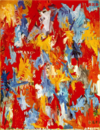Midterm 2 Slides Flashcards
(28 cards)

Flag
Jasper Johns
1954-55
first mature work (attempted to destroy previous works), dreamt of work from source of Rauschenberg’s Yoicks (very Freud), relationship between material and paint

Target with Plaster Casts
Jasper Johns
1955
uncomfortable idea of people in front of targets, undecided as a painting or object or both or neither

Flag above White with Collage
Jasper Johns
1955
figure and ground united, white indistinguishable from stripes

Book
Jasper Johns
1957
word play red/read, status of object is not decidable

False Start
Jasper Johns
1959
matches/mismatches language and reality with colors and titles

Fool’s House
Jasper Johns
1962
broom or representation of the broom (Duchamp)?, is the cup real/representation because it’s outside of frame

The Bride Stripped Bare by her Bachelors, Even (The Large Glass), The Bride Stripped Bare by her Bachelors, Even (The Green Box)
Marcel Duchamp
1915-23, 1934
recursive/language like Johns, box was created later, self-contained, Fluxus Year Boxes

Composition 1960 #5
La Monte Young
1960
indeterminate length of performance, aimed at teseting/going beyond Cage,

score for Poem for Tables, Chairs, Benches, etc.
La Monte Young
1960
first mature work according to Joseph, indeterminacy because of uneveness of floor, moves indeterminacy from score into material

Chair Event (score and realization)
George Brecht
1962 score, 1970’s realization
model for linguistic score to initiate material realization, indeterminate realization, spectral colors come from Brecht’s desire to relate to painting

Reading of George Maciunas’ manifesto, “Neo-Dada in Music, Theater, Poetry, Art” at the “Après John Cage” festival
Wuppertal, Germany
1962
wants to recover dada from neo, sees hybridity, to surpass Cage you must do it through dividing art/life

Audience Piece
Yoko Ono
1962
reverse roles of performer and audience like comp #6, places of audience and performers interchangable based on power

Cut Piece
Yoko Ono
1964
gendered dynamic of being acted upon, the fragment and atomic age (war as visual culture)

The Cabinet
George Brecht
1959
objects are placed in it moving from room to object (instead of R moving from object into the room), transparent in the Cagean sense (external things become part of it)

Word Event (Exit)
George Brecht
1961
de-skilling using something super banal, anyone can exit, movement between language and readymade object

Proposition #2
Alison Knowles
1962
art/life, like much of Fluxus works exists as score but lends itself to performance

Box with the Sound of Its Own Making
Robert Morris
1961
perform role of listener by listening to recording (Cage did it, called it performance), self-contained, also a score for another performance (it can be measured and reproduced)

Untitled
Claes Oldenburg
1960
visual representation of sounds in Snapshots of the City, scatological

Untitled [Composition with Black Pouring]
Jackson Pollock
1947
influenced Oldenburg (scatology, visual, environment), point of departure for Happenings (painted on floor)

Cut-Out
Jackson Pollock
1948-50
Ohara sees it as something scupltural and hybrid, cut away from abstract field to create figure in negative, figuration/abstraction in state of negation

Limbour as a Crustacean
Jean Dubuffet
1946
engaged with inscription and graffiti, idea of art brut (art of the outsider) from him

The Street
Claes Oldenburg
1960
inscription and graffiti (O was interested in graffiti as part of popular culture), engagement of pictorial field with writing (like Twombly and R), comic book tradition, low art, environments

The Store
Claes Oldenburg
1961
notion of the fragment, commodity fetishism (consumer desire projected onto object), between sculpture and painting

“Empire” (“Papa”) Ray Gun
Claes Oldenburg
1959
phallic/testicular, relation to Freud’s fetishism (lack of phallus), both is and is not a phallus






